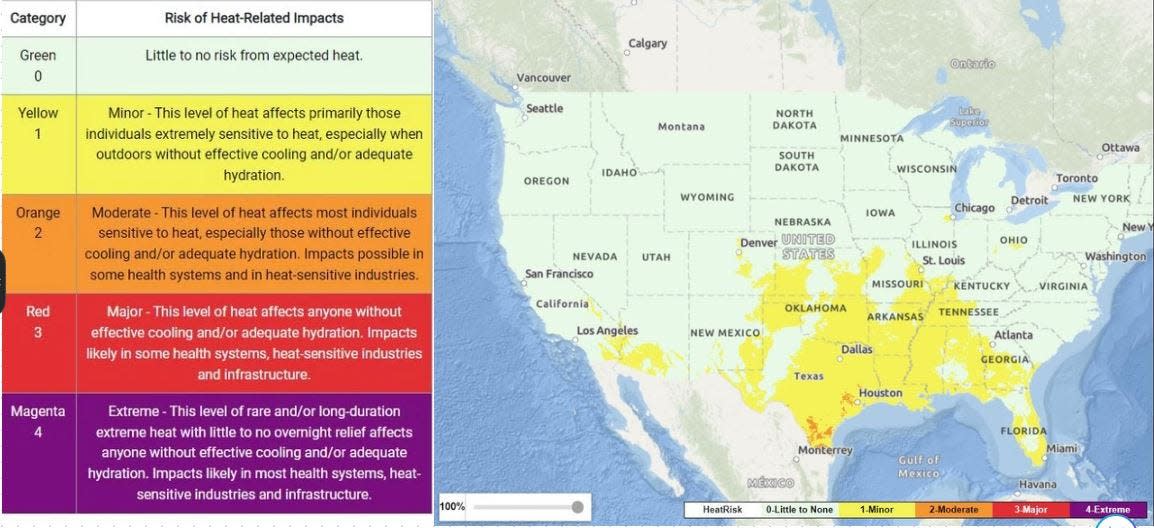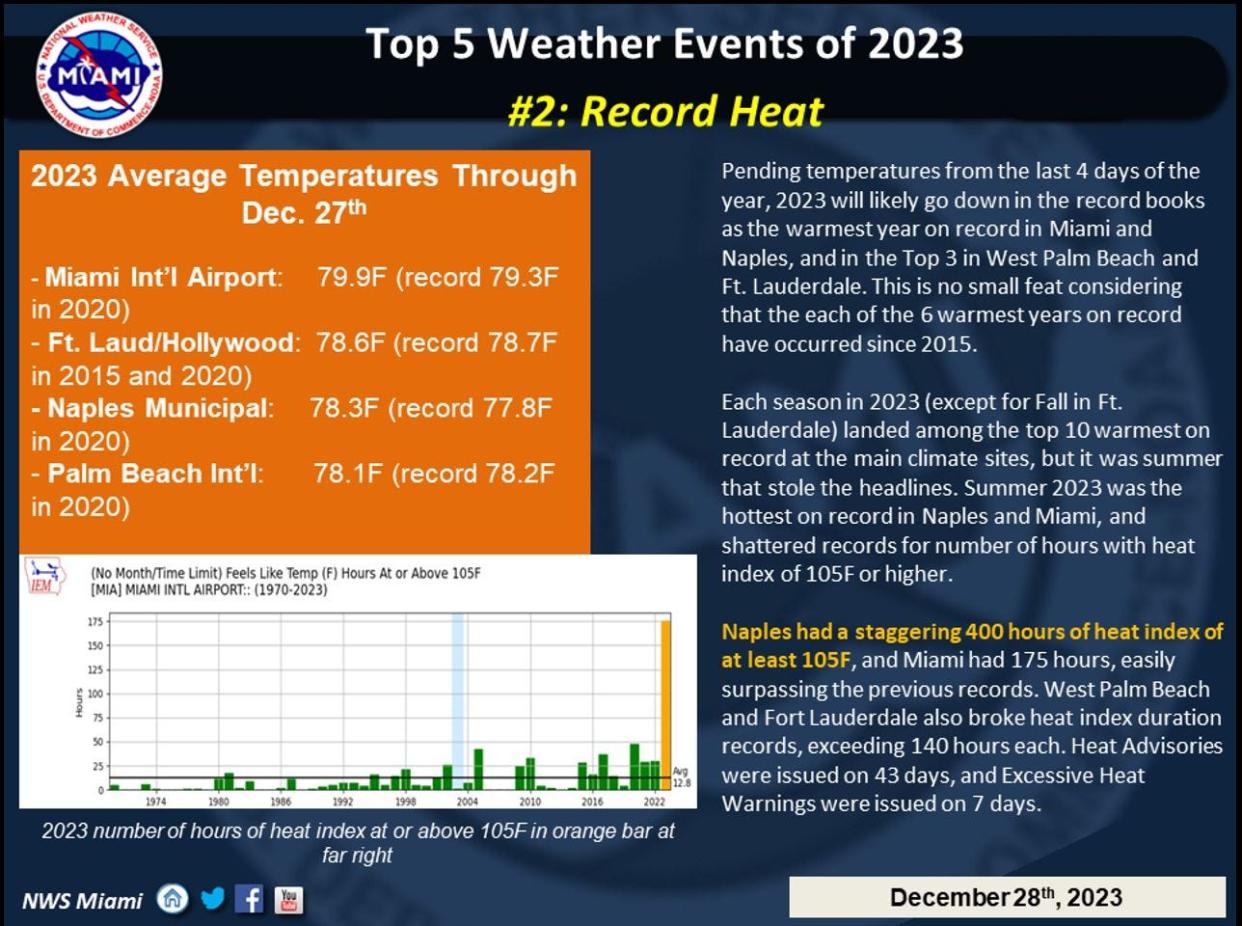Climate change triggers new Florida heat warning chart that alerts when it could be deadly outside
Molten air smothered South Florida last summer with an unprecedented streak of heat advisories and excessive heat warnings as high temperatures and humidity created treacherous outdoor extremes.
With the potential for similar scorchers in the coming months and years, the National Weather Service is testing a new heat risk index that it hopes will better translate the possible health complications triggered when the mercury rises to misery.
Like the Air Quality Index and the UV Index, the new ranking system assigns numbers to risk levels that include who is most susceptible to health problems at each level and actions that should be taken to reduce risks.
Man's death in South Florida heat: Prompts federal investigation into company that employed him
The heat risk index, first used in 2013 in California and expanded to some western states in 2017, debuted nationwide in an April 22 announcement by the NWS and Centers for Disease Control and Prevention.
“Extreme heat is the leading weather-related killer in the U.S. and is expected to increase in frequency and intensity with less of the overnight relief we rely on,” said National Weather Service Deputy Director Michelle Mainelli during the announcement.
The CDC says about 1,220 people in the U.S. die from heat-related illnesses each year and note that the number is likely an undercount.
Since 1895, Florida’s average annual temperature has increased about 1.6 degrees, according to the Florida Climate Center.
What we need: More trees, not cooling centers, are south Florida's answer to increasingly hot summers
Palm Beach County could experience 30 additional days a year of temperatures 95 degrees or higher if the Earth's temperatures rise 3.6 degrees (2 degrees Celsius) above the pre-industrial average.
Last year at Palm Beach International Airport, six days reached 95 degrees or higher. Four days in 2022 hit the 95-plus mark, and nine days in 2020.
'Deadly' Florida heat is possible at highest risk level

The new heat risk maps give a seven-day forecast and were custom-designed to consider climatology by county. That means in South Florida, where people may be more acclimated to warmer temperatures, there is a higher threshold to trigger a heat risk rating.
Four factors are considered when deciding risk level, which has five categories from 0 to 4. Those include how much above normal the temperatures are, the time of year, whether the temperatures are known to cause heat-related illnesses and the duration of the unusually high temperatures, such as whether they extend into the overnight hours.
More: Man's death in South Florida heat prompts federal investigation into company that employed him
At Level 1, most people should be able to tolerate the heat with only those extremely sensitive to warmer temperatures affected. A Level 4 means the entire population is at risk with potentially “deadly” high temperatures. Poor air quality and increases in emergency room visits are also likely at Level 4.
“It’s more common than you expect,” said Good Samaritan Medical Center chief of staff George Gurdock about heat-related emergency room visits.
Gurdock, also medical director for the Palm Beach Health Network emergency departments, said he sees about two heat-related health emergencies per week during the summer.
What are the warning signs of heat exhaustion and heat stroke?
“Sometimes it's people from other parts of the country who come down here to vacation and don’t recognize that exerting themselves outside puts them at risk of heat exhaustion,” Gurdock said. “We’ve seen construction workers, roofers, people detailing cars or boats or just the Sunday pickleball player.”
Gurdock said peoples’ temperatures can reach 103 to 104 degrees during heat exhaustion or heat stroke with symptoms that include muscle cramps, excessive sweating, throbbing headache, passing out, confusion and seizures.
Climate change: 126 days with temps that feel like 105 degrees? Florida's headed that
“You want to cool them as quickly as possible,” he said. “I don’t think anyone in my career has succumbed to heat stroke, but I’ve had people come in very sick with it.”
Not directly considered in the new heat risk rating is humidity, which plagues South Florida's summer months and limits the effectiveness of the body’s natural evaporative cooling system — sweat. NWS and CDC officials said there wasn’t enough long-term data on humidity to include in the risk rating.
Why it was so hot last summer in West Palm Beach?
A weak Bermuda High that reduced afternoon sea breezes combined with above-average sea surface temperatures led to a streak of dangerously warm days in South Florida during the summer of 2023.
While August ended as the sixth warmest on record in West Palm Beach with an average temperature of 84 degrees, the “feels like” or heat index temperatures are not included in official temperature tallies.
Robert Molleda, warning coordination meteorologist for the NWS in Miami, said West Palm Beach had heat index values of 105 degrees or greater for more than 130 hours last year. That broke the previous record of 50 in 2011.

Heat index values of 110 degrees or greater were measured in West Palm Beach for 10 hours, surpassing the previous record of four hours in 2009.
There were 39 days under a heat advisory in Palm Beach County, and three excessive heat warnings. Both alerts are based on heat index temperatures, and both set records.
“Mostly in our business we are moving every couple of hours between jobs and that’s helpful,” said Scott Lewis, who owns West Palm Beach-based Scott Lewis' Gardening and Trimming, about dealing with the summer heat. “And we get frequent afternoon thunderstorms to cool things off, but it’s going to be another rough summer.”
The Climate Prediction Center, an office within the National Oceanic and Atmospheric Administration, says most of the country will have above-normal temperatures June through August, including a 50% to 60% chance that Florida will be warmer than average.
Kimberly Miller is a journalist for The Palm Beach Post, part of the USA Today Network of Florida. She covers real estate and how growth affects South Florida's environment. Subscribe to The Dirt for a weekly real estate roundup. If you have news tips, please send them to kmiller@pbpost.com. Help support our local journalism, subscribe today.
This article originally appeared on Palm Beach Post: New Florida heat risk index as climate change makes summers hotter
